Materials Science and Engineering: A ( IF 6.1 ) Pub Date : 2020-03-29 , DOI: 10.1016/j.msea.2020.139288 Partha Duley , Souriddha Sanyal , T.K. Bandyopadhyay , Sumantra Mandal

|
A cast and homogenized Mg–4Zn-0.5Ca-0.16Mn (wt.%) alloy is hot forged at different temperatures (523–623K) employing a new ‘hard plate hot forging’ technique. During the forging operation, the coarse Ca2Mg6Zn3 phase facilitates dynamic recrystallization (DRX) through particle stimulated nucleation (PSN) process. This phenomenon eventually leads to the evolution of bimodal grain size distribution and basal texture in all the forged specimens. The specimen forged at 573K exhibits higher DRX fraction as compared to the specimens deformed at lower (523K) or higher (623K) temperature, due to the pronounced PSN effect originated from the higher fraction of Ca2Mg6Zn3 phase. The texture intensity in the specimen forged at 573K is stronger due to the higher fraction of DRX grains, since the DRX grains exhibit typical basal texture. This specimen exhibits a combination of high room temperature strength (YS ∼259 MPa, UTS ∼304 MPa) and moderate ductility (eu ∼4.2%, ef ∼6.5%) owing to the higher basal texture intensity, bimodal grain size distribution, higher fraction of second phase and the presence of nano-sized Mn precipitates. Following annealing of this specimen at 623K for 5 min, an excellent strength-ductility balance (YS ∼142 MPa, UTS ∼241 MPa, eu ∼15%, ef ∼19%) is achieved. Such improvement in the tensile properties following annealing has been attributed to the combined influence of the retention of grain size heterogeneity, the weakening of basal texture and presence of nano-sized Mn as well as precipitates.
中文翻译:

Mg-Zn-Ca-Mn合金热锻和退火硬质合金的晶粒尺寸分布,析出相和织构发展对其拉伸性能的影响
使用新的“硬板热锻”技术在不同温度(523-623K)下对铸造且均质的Mg-4Zn-0.5Ca-0.16Mn(wt。%)合金进行热锻。在锻造过程中,粗大的Ca 2 Mg 6 Zn 3相通过颗粒激发成核(PSN)过程促进了动态重结晶(DRX)。这种现象最终导致所有锻造样品中双峰晶粒尺寸分布和基础纹理的演变。与在较低(523K)或较高(623K)温度下变形的标本相比,在573K锻造的标本中显示出更高的DRX分数,这是由于Ca 2 Mg 6 Zn 3的较高分数引起了明显的PSN效应。相。由于DRX晶粒表现出典型的基础纹理,由于DRX晶粒的比例更高,因此在573K锻造的试样中的纹理强度更强。这标本表现出高室温强度(YS ~259兆帕,UTS ~304兆帕)和中度延展性(E组合ü ~4.2%,E ˚F ~6.5%)由于较高的基础织构强度,双峰粒度分布,第二相的分数较高,并且存在纳米级Mn沉淀。5分钟以下,在623K此试样的退火,优异的强度和延展性的平衡(YS ~142兆帕,UTS ~241兆帕,电子ü〜15%,E ˚F达到19%)。退火后拉伸性能的这种改善归因于以下因素的综合影响:晶粒尺寸异质性的保持,基础织构的弱化和纳米级Mn的存在。 沉淀。











































 京公网安备 11010802027423号
京公网安备 11010802027423号